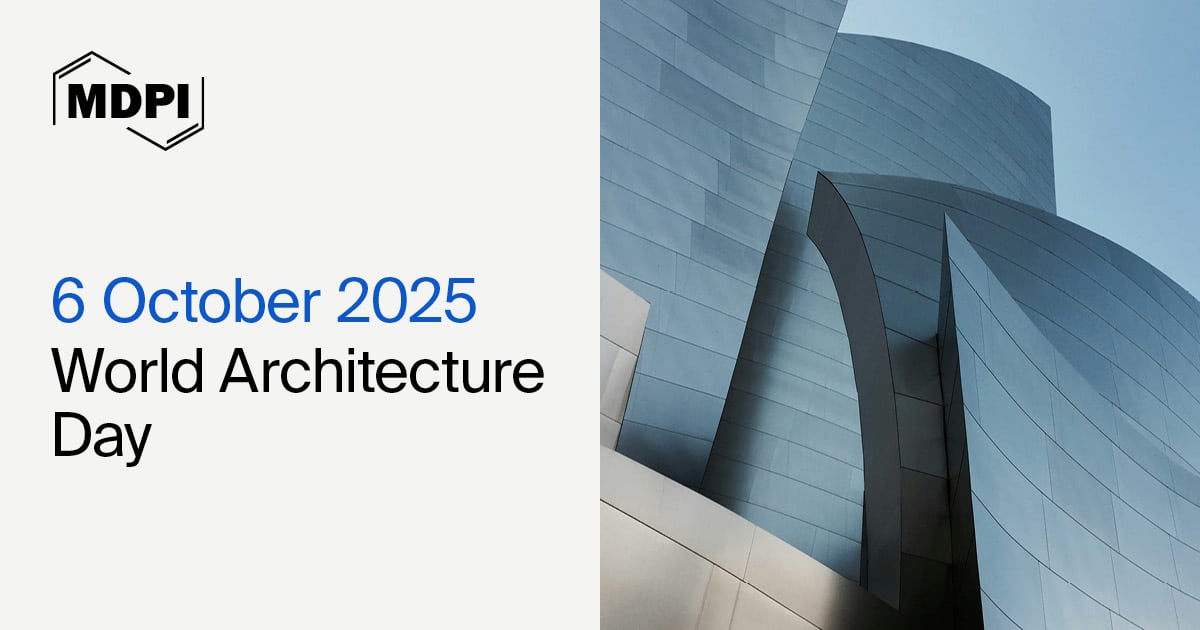
Journal Menu
► ▼ Journal Menu-
- Energies Home
- Aims & Scope
- Editorial Board
- Reviewer Board
- Topical Advisory Panel
- Instructions for Authors
- Special Issues
- Topics
- Sections & Collections
- Article Processing Charge
- Indexing & Archiving
- Editor’s Choice Articles
- Most Cited & Viewed
- Journal Statistics
- Journal History
- Journal Awards
- Society Collaborations
- Conferences
- Editorial Office
Journal Browser
► ▼ Journal BrowserNeed Help?
Announcements
29 September 2025
World Architecture Day—“Design for Strength”, 6 October 2025

World Architecture Day, observed annually on the first Monday of October, is a global initiative that highlights the critical role of architecture in addressing societal challenges while promoting sustainable and equitable development of built environments. Established by the International Union of Architects (UIA) in 1985, this day has become a vital platform for advancing architectural innovation and raising public awareness about the transformative power of design.
Aligned with the 2025 theme, “Design for Strength”, and Goal 11 of the UN Sustainable Development Goals (Sustainable Cities and Communities), MDPI emphasizes the need for resilient, adaptive, and inclusive architectural solutions. In an era of rapid urbanization and climate uncertainty, architects and researchers are pioneering groundbreaking approaches—from disaster-resistant structures to carbon-neutral materials—that fundamentally redefine how we build and inhabit spaces.
Join us in celebrating World Architecture Day and supporting initiatives that empower architects to create a more sustainable and resilient future. Together, we can shape built environments that not only withstand the tests of time and transformation but also foster equity, well-being, and harmony between humanity and nature.

|
Engineering |
Chemistry & Materials Science |
Environment & Earth Sciences |

Invited Speakers:
 |
 |
 |
 |
|
Prof. Dr. Derek Clements-Croome, |
Dr. Paris Fokaides, |
Dr. Ehsan Harirchian, |
Prof. Dr. Umberto Berardi, |
Free to register for this webinar here!

We are honored to interview Dr. Paris Fokaides from Frederick University, Cyprus, on his research journey and insight.
 |
Name: Dr. Paris Fokaides “Academic work on ‘design for strength’ must integrate performance simulations, life cycle thinking, and smart readiness assessments to ensure designs are not only safe and durable, but also sustainable and responsive.” Please read the full interview here. |

“Comparison of Pulse-Echo Tomography and Through-Transmission Ultrasonic Test for UPV Characterization of Building Materials”
by Emilia Vasanelli, Davide Di Gennaro, Matteo Sticchi, Gianni Blasi and Luigi Capozzoli
Infrastructures 2025, 10(7), 162; https://doi.org/10.3390/infrastructures10070162
“An Ontology-Aided Generative Computational Design Process for Ecological Building Envelopes: Development of a Conceptual Framework for the Early Design Stage”
by Michael Hensel, Jakub Tyc, Albin Ahmeti and Defne Sunguroğlu Hensel
Land 2025, 14(4), 840; https://doi.org/10.3390/land14040840
“AI-Driven Innovations in Building Energy Management Systems: A Review of Potential Applications and Energy Savings”
by Dalia Mohammed Talat Ebrahim Ali, Violeta Motuzienė and Rasa Džiugaitė-Tumėnienė
Energies 2024, 17(17), 4277; https://doi.org/10.3390/en17174277
“Application of Long-Period Fiber Grating Sensors in Structural Health Monitoring: A Review”
by Ying Zhuo, Pengfei Ma, Pu Jiao and Xinzhe Yuan
CivilEng 2024, 5(3), 559–575; https://doi.org/10.3390/civileng5030030
“Recycling Potential of Construction Materials: A Comparative Approach”
by Matan Mayer
Constr. Mater. 2024, 4(1), 238–250; https://doi.org/10.3390/constrmater4010013
“A New Method for Defining the Optimal Separation Gap Distance and the Acceptable Structural Pounding Risk on Multistory RC Structures”
by Maria G. Flenga and Maria J. Favvata
Appl. Sci. 2024, 14(3), 1165; https://doi.org/10.3390/app14031165
“A Simple and Effective Method to Evaluate Seismic Maximum Floor Velocities for Steel-Framed Structures with Supplementary Dampers”
by Alexia Kosmidou, Foteini Konstandakopoulou, Nikos Pnevmatikos, Panagiotis G. Asteris and George Hatzigeorgiou
Appl. Mech. 2023, 4(4), 1114–1126; https://doi.org/10.3390/applmech4040057
“Effects of Chemicals Exposure on the Durability of Geopolymer Concrete Incorporated with Silica Fumes and Nano-Sized Silica at Varying Curing Temperatures”
by Sagar Paruthi, Ibadur Rahman, Asif Husain, Mohd Abul Hasan and Afzal Husain Khan
Materials 2023, 16(18), 6332; https://doi.org/10.3390/ma16186332
“Innovative and Sustainable Composite Material for the Seismic and Energetic Upgrade of Historic Masonry Buildings”
by Dora Pugliese, Valerio Alecci, Rosa Romano, Gianfranco Stipo, Mario De Stefano and Antonio Nanni
Fibers 2023, 11(9), 76; https://doi.org/10.3390/fib11090076
“Evaluation of the Performance and Durability of Self-Cleaning Treatments Based on TiO2 Nanoparticles Applied to Cement-Based Renders and Boards”
by Alberto Fregni, Luca Venturi and Elisa Franzoni
Coatings 2023, 13(6), 990; https://doi.org/10.3390/coatings13060990
“Predicting Energy Consumption in Residential Buildings Using Advanced Machine Learning Algorithms”
by Fateme Dinmohammadi, Yuxuan Han and Mahmood Shafiee
Energies 2023, 16(9), 3748; https://doi.org/10.3390/en16093748
“Key Building Design and Construction Lessons from the 2023 Türkiye–Syria Earthquakes”
by Iftekhar Ahmed
Architecture 2023, 3(1), 104–106; https://doi.org/10.3390/architecture3010007

|
“Resilience and Sustainability in Architecture and Urban Planning: Policies, Practices, Strategies and Visions, 2nd Edition” |
“BioCognitive Architectural Design” |
 |
 |
|
“Incorporating Advanced New or Recycled Materials in Reinforced Concrete Structures” |
“Mineral and Metal Materials in Civil Engineering” |
 |
 |




